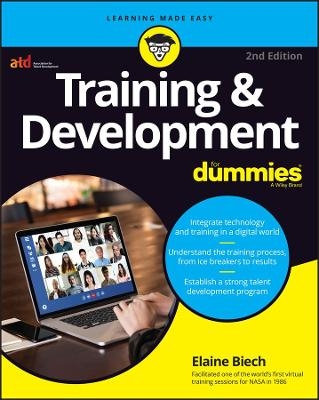
Training & Development For Dummies
For Dummies (Verlag)
978-1-119-89600-5 (ISBN)
One of the best ways to retain great talent in your business is to deliver a strong training and development program—and this book gives you the tools to do just that. Featuring the latest strides in talent development, such as social learning, hybrid training, creating videos, and more, it arms you with everything you need to upskill employees to be more effective, productive, satisfied, and loyal.
Develop a robust training and development program
Foster a supportive and innovative work environment
Use mentoring, coaching, and informal learning effectively
Align learning to your organization’s needs
Engage your employees with a motivating training program using the helpful guidance in Training & Development For Dummies!
Elaine Biech is president and managing principal of ebb associates inc, an organizational and leadership development firm that helps organizations work through large-scale change. Her 30 years in the training and consulting field include support to private industry, government, and non-profit organizations.
Foreword xv
Introduction 1
About This Book 2
Foolish Assumptions 2
Icons Used in This Book 3
Beyond the Book 4
Where to Go from Here 4
Part 1: So You’re Going to Be a Trainer 5
Chapter 1: Exploring Training and Talent Development 7
Introducing the Exciting Role of Training 8
Learning happens all the time 9
Understanding why training is necessary 10
Learning is essential to career advancement 13
Training isn’t just for business 13
Discovering What Trainers Do 14
Assessing your training potential 15
Taking stock of your skills 16
Scoring your self-assessment 17
How do you become a trainer? 20
Exploring the Terminology of Talent Development 22
Who’s who? 23
What’s what? 24
Experiencing the Advent of the Talent Development Role 25
Merging training and talent development 25
Realizing the many hats worn by a 21st century
TD professional 26
Determining whether you have what it takes 28
Chapter 2: How Adults Learn 31
Learning About Adult Learning Theory 31
Meeting Malcolm Knowles 32
Applying adult learning theory to training 33
Understanding How People Learn 35
The science of learning 35
Three types of learning: KSAs 36
What we know for sure about how we learn 38
Brain-based learning: It’s a no-brainer 39
The growth mindset 41
The 70-20-10 learning framework 42
Ensuring That Adults Learn in the Classroom, Online, and on the Job 45
Create a safe haven for learning 45
Create a comfortable environment 46
Encourage participation 48
Facilitate more than you deliver 48
Chapter 3: Introducing the Training Cycle 51
The Training Cycle: An Overview of ADDIE 52
Analyze needs 53
Design the training 53
Develop the program 54
Implement the design 56
Evaluate the results 56
Add a touch of design thinking 58
Talking the T&D Talk 59
Learning and the Training Cycle 62
Variety and flexibility 63
Conditions of learning 63
Part 2: T&D: The Training Part 65
Chapter 4: Analyzing Needs and Designing Learning 67
ADDIE: Starting with Evaluation in Mind 68
Analyze by Conducting a Needs Assessment 68
The why, how, who, and when of needs assessment 69
Is training really what’s needed? 76
If your time is limited 78
Designing the Learning 80
Aligning to your organization’s needs 80
Planning how to deliver your content 81
Writing Objectives 83
What objectives should do 83
Task analysis 87
Chapter 5: Developing the Training Program 89
Deciding Where to Begin 91
Choosing virtual, classroom, or hybrid 92
Using hybrid models 94
Starting to develop a program 95
Developing a Dynamic Opening 96
Warming things up with icebreakers 97
Considering other elements your participants expect 98
Developing the Body to Ensure That Learning Occurs 100
Knowing the value of lectures 101
Contemplating countless alternatives to a lecture 103
Selecting activities 110
Adding Zest with Visuals 115
Knowing why you need visuals 115
Creating effective visuals 116
Planning for Inclusivity 118
Reflecting diversity in learning and development content 118
Planning for inclusive learning environments 119
Designing a Finale That Brings Closure 120
Ensuring that you’ve met expectations 121
Providing a shared group experience 121
Evaluating the learning experience 121
Requesting feedback and suggestions 122
Summarizing accomplishments 122
Ending on a high note 122
Selecting Off-the-Shelf Materials 123
Determining whether off-the-shelf materials meet your needs 124
Adapting the design of a prepackaged program 124
Pulling It All Together 125
Understanding factors that affect a design 126
Applying strategies for a good design 127
Developing materials 128
Chapter 6: Implementing Learning: It’s Showtime 131
Opening Your Training Session with a BANG, Online or Off 132
Build interest in the session 133
Ask what participants know and what they want to know 133
Note the ground rules and what to expect 133
Get participants involved 135
Avoiding Seven Disastrous Debuts 136
Creating a Supportive Learning Environment 136
Get to know your participants 136
What’s in a name: Five secrets to remembering names 137
Let them know about you 140
Training Like a Pro 140
Presentation skills 140
The participants’ materials 145
Notes: To be or note to be 146
Asking and Answering Questions 148
Encouraging participants to ask questions 149
Answering questions: Some guidelines 150
Asking questions 151
Creating Smooth Transitions 152
Wrapping Up an Effective Training Session 153
Providing a shared group experience 154
Evaluating the learning experience 154
Gaining commitment to action 154
Sending people off with a final encouraging word — or two 155
Chapter 7: Evaluation: It’s Not Over Yet! 157
Grasping the Purpose of Evaluations 158
Reviewing Kirkpatrick’s Four Levels of Evaluation 159
Level 1: Reaction 160
Level 2: Learning 161
Level 3: Behavior 162
Level 4: Results 163
Guidelines for measuring the Four Levels 163
Taking a deeper look at evaluation methods 171
Using ROI for Training 173
Exploring the ROI process 174
Knowing the benefits of ROI 175
Evaluation: The Last Training Cycle Stage but the First Step to Improvement 178
Chapter 8: Getting Results: Transfer of Learning 181
Making Your Training Memorable: Follow-Up for the Other 50 Percent 182
Recognizing barriers to transfer of learning 182
Using strategies for transfer of learning 183
Doing What Great Trainers Do after Training 188
Understanding Your Talent Development Professional Role 189
Part 3: What ADDIE Doesn’t Tell You 193
Chapter 9: Being Prepared to Succeed 195
Preparing Your Environment 196
Knowing when, where, what, and who 196
Making onsite room arrangements 197
Getting equipment and visuals ready 201
Preparing Your Participants 205
Preparing participants: What works? 205
Using unique virtual participant preparation 206
Preparing participants: What doesn’t work? 207
Preparing Yourself 208
Preparing to avoid crises 208
Preparing for Virtual ILT 210
Finding out who’s in your session 211
Practice, practice, practice 212
Tips for staying organized 213
Preparing your body and brain 216
Tips for traveling if you must 217
The procrastinator’s checklist 217
Last-minute virtual session preparation 220
Doing Double Duty for Hybrid Delivery 220
Chapter 10: Your Job as a Facilitator 225
Training, Facilitating, and Presenting: What’s the Difference? 226
Are you a trainer or a facilitator? 226
Using facilitative skills when you present 228
Facilitating Successful Training 230
Experience is the best teacher 233
Tips for facilitating activities 235
Participation Prescription: Continue to Increase the Dosage 238
Gotta play the game to perform 238
Participants’ expectations of participation 240
Increasing participation — or why are they called “participants”? 240
REACTing 249
Chapter 11: Mastering Media and Other Visuals 251
Selecting the Best Visual to Do the Job 252
Knowing what’s available 252
Understanding the benefits 254
Creating Your Own Powerful Video 255
Ensuring That Visuals Add to the Learning 257
Computer projection systems 257
Videos 258
Participant devices 258
Flip charts 259
Boards of all types (including electronic) 261
Props 262
Presenting Like a Pro 263
Using visuals in general 263
Using specific media and visuals 265
Exploring the Other Media: Social 269
Hot Tips for a Cool Ending 272
Chapter 12: Addressing Problems: What’s a Trainer to Do? 273
Tackling Training Problems 273
Uncovering logistics problems 274
Coping with equipment problems 274
Accepting personal situations 277
Confronting difficult group situations 279
Learning that training is not the solution 281
Taking a COOL approach 283
Using humor to deal with problems 283
Managing Disruptive Behaviors 284
Preventing disruptions 285
Managing disruptive types 286
Addressing Virtual ILT Problems 290
Not enough time to get participation 290
Attending to distracted participants 290
Reading body language 291
Sweaty Palms, Parched Throat: Overcoming Nervousness 291
Understanding pre-performance jitters 292
Accepting your nervousness as natural 292
Mastering nervous symptoms 294
Tips for specific anxiety problems 298
Preventing and Resolving Problems 300
Part 4: T&D: The Talent Development Part 301
Chapter 13: Your Talent Development Role 303
Expanding Talent Development 304
Onboarding 305
Leading change 306
Coaching managers 306
Coordinating mentoring opportunities 306
Internal consulting 307
Building teams 307
Transforming Workplace Learning 308
Seeing how talent development is important to organizations 308
Confirming that talent development is important to employees 310
Supporting the C-Suite 311
Discovering Your Organization’s Learning Foundation 312
Determining an organization’s talent development readiness 314
Describing the TD foundation 315
Summarizing your TD responsibilities 315
Exploring the TD organizational readiness checklist 316
Is Your Organization Ready? 320
Chapter 14: Building a Learning Culture 321
Defining a Learning Culture 322
The Rationale for a Learning Culture 323
Learning Organizations and Learning Culture 324
Imagining your organization’s learning culture 324
Knowing what inhibits a learning culture 325
Cultivating Your Organization’s Learning Culture 326
Getting your leaders involved 327
Linking learning to business 327
Taking action 329
Sustaining a Learning Culture 335
Maintaining the Culture with Logistics 336
Governing body 337
Senior leadership role 337
Annual update 337
Communication and marketing 337
Continued accountability for the effort 338
Can Organizations Learn? 338
Chapter 15: Employee Development Is Everyone’s Job 339
Exploring Organizational Mindsets 339
Having a growth mindset 340
Having a learning mindset 340
Recognizing other mindsets 340
An organizational mindset for today’s learner 341
Ensuring That Managers Develop Employees 342
Helping managers be better coaches 343
Helping managers and supervisors with development ideas 344
Helping managers give better feedback 344
Creating Employee Accountability for Their Own Development 348
Delivering Learning through Others 348
Helping the part-time trainer 349
Enhancing team learning 350
Influencing informal learning on the job 352
Revealing Six Secrets to Build Successful Partnerships with SMEs 352
Secret 1: Clearly define the expectations you have for the SME 353
Secret 2: Use criteria to select SMEs 353
Secret 3: Ease new SMEs into their roles 354
Secret 4: Tap into the SME’s expertise 354
Secret 5: Adapt your style 355
Secret 6: Provide timely feedback and appreciation 355
Part 5: The Professional Trainer 357
Chapter 16: The Consummate Professional 359
Growing Professionally 359
Attend formal learning events 360
Search for certification and classes in many topics 360
Ask others 361
Do it yourself 362
Going the Extra Mile: Stay on Top of Your Game! 364
Go from good to great 364
Where’s your energy? Stay pumped! 365
Design 367
What does being professional mean to you? 367
Giving Back to the Profession 370
Chapter 17: Talent Development Certification 373
Introducing ATD 374
Finding out why ATD’s mission is important 374
Understanding what ATD does 375
Accessing resources through ATD 375
Understanding ATD’s Talent Development Capability Model 376
Getting an overview of the Capability Model 376
Recognizing the value of a competency framework 379
Certification: What It Means for You 380
Knowing the difference between certification and certificate programs 380
Understanding the value of certification 381
Taking a Quick Look at ATD CI Certification 382
Seeing the link between capabilities and certification 383
Applicant process 383
Being a role model for learning 385
Chapter 18: The Future of the Talent Development Profession 387
Envisioning the Workplace of the Future 388
Living in the midst of a colossal change 388
Blame it on the virus and VUCA 391
Identifying how VUCA relates to you 392
Exploring the Changing TD Environment 394
Spending is increasing for talent development 394
Finding and retaining talent is vital 395
Coaching the essentials is key 395
Encouraging continuous learning 396
Planning for a metaverse future 397
Tapping into training technology 397
Making use of brain-based learning 398
Seeing how less is more 399
Embracing virtual learning 399
Training on the run 400
Including DEI and culture 401
Preparing millennials for leadership roles 401
Helping Everyone Learn to Learn 402
Seizing the Future of Learning 403
Preparing Yourself for Change 404
Exploring content for a changing world 405
Researching new roles 406
Becoming a lifelong learner 408
Sharpening your skills 409
Taking stock; taking action 409
Maintaining your personal spark 409
Part 6: The Part of Tens 411
Chapter 19: Ten Virtual Warm-Ups 413
Someone Once Said 414
Test Their Mettle 414
Chat Away 415
Expect Expectations 415
At the Movies 416
Going Live 416
Vote Early, Vote Often 416
Show Me the Picture 417
How Was the Homework? 417
Annotate It 417
Chapter 20: Ten Quick Ways to Enable Social Learning 419
Blogs for Your Future 419
Accountability Partners or Trios 420
Personal Learning Groups 420
Follow Up with Fun 421
DIY Career Paths 421
Peer Coaching Circles 421
Video Posts 422
Volunteer Activities 422
Feedback Incentive 423
Pictures of Proof 423
Index 425
| Erscheinungsdatum | 12.08.2022 |
|---|---|
| Sprache | englisch |
| Maße | 183 x 231 mm |
| Gewicht | 612 g |
| Themenwelt | Wirtschaft ► Betriebswirtschaft / Management |
| ISBN-10 | 1-119-89600-2 / 1119896002 |
| ISBN-13 | 978-1-119-89600-5 / 9781119896005 |
| Zustand | Neuware |
| Haben Sie eine Frage zum Produkt? |
aus dem Bereich


